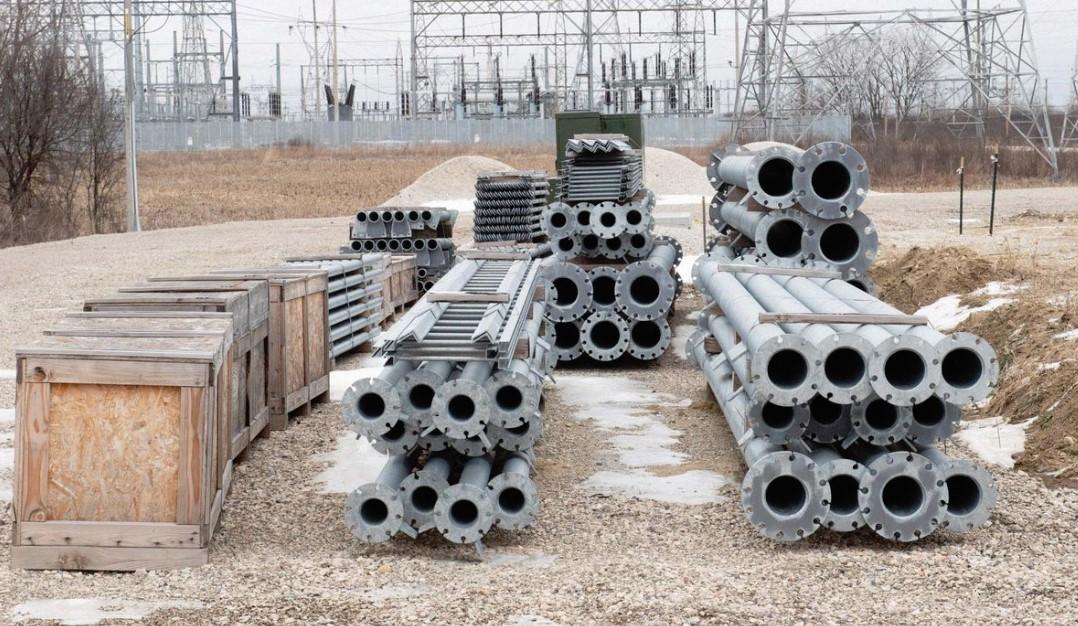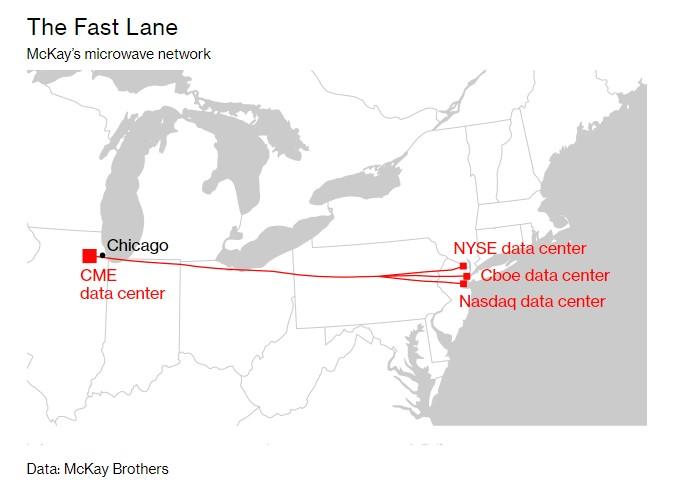The small town of Aurora, Illinois – best known for being Wayne‘s hometown in Wayne’s World – has another peculiar appeal to its location: it is one of the closest places that high frequency traders can get to the $63 billion CME Group exchange, where futures and derivatives on commodities and US treasuries trade making it a mecca for HFTs seeking to frontrun slower orderflow. That makes local real-estate extremely coveted, as detailed in a recent Bloomberg follow up to Michael Lewis' "Flash Boys".
The story is familiar to anyone who has been reading this website for the past decade, or leafed through Michael Lewis' HFT thriller: the closer traders can collocate to the CME, the more likely they are to shave off milliseconds from their trades, resulting in frontrunning of slower orderflow that can net them millions. For instance, this small brick hut is owned by New Line Networks a joint venture of HFT giants Jump Trading and Virtu Financial: the two paid $14 million for the land just to be close to the CME Group.

Not happy with the arrangement, Chicago HFT titan DRW Holdings wishes to be even "faster" than Jump and Vitru, and plans to move just a few yards closer to the exchange, having recently put an antenna on a light pole. Next to that is yet another light pole that has been rigged with antennas owned by McKay Brothers, an Oakland-based company. Meanwhile, on nearly all the roads in the area, trading companies have erected antennas or rented space on towers and poles, all of them littered with white circular dishes to try and get closer to the CME data center, all for the purpose of frontrunning slower traders, even if there are still no lasers to be seen, unlike what a visitor to the NYSE in Mahwah, NJ can observe.
As Michael Lewis first hinted in 2014, the real-estate scramble around the exchange had become a turf war between rival HFT corporations until one company decided it was going to do something about the constant jostling back-and-forth between high frequency traders. Dallas-based CyrusOne, which owns the CME center, decided last year that it would finally end the scramble for real-estate by putting up a 350 foot tall wireless tower that would allow anybody to rent space on it. It’s closer than any trading firm could get to the center and targeted putting everybody "on equal footing"... in exchange for a very generous fee to CyrusOne, of course.
And although the tower has room for about 35 satellite dishes but, to this day, remains unused.
Why? Because yet another smaller company, Scientel Solutions LLC, has announced plans to build its own tower about 1000 feet east of CyrusOne's tower, which CyrusOne says would block its own "line of sight" to downstream microwave dishes, and interfere with its communication to and from the CME data center. To prevent this potentially catastrophic development, CyrusOne sued to block Scientel's tower.
And with the litigation ongoing, Scientel's development site remains 2.6 mostly vacant acres that house only a trailer, a portable toilet, and a pile of metal poles.

Amid the legal fray, elected officials in Aurora find themselves confused, trying to figure out which projects should be approved and which projects should be rejected. It appears that the elected officials didn’t initially understand the weight of the decisions that they were making in approving and rejecting these towers. For instance, Alderman Bill Donnell described his technological know-how by saying: “I came from being a guy who didn’t know where the cloud was to realizing speed matters. I didn’t realize being a millisecond faster was all that important."
Actually being a nanosecond faster is just as important, hence the litigation: microwave networks rely on line-of-sight transmissions as microwaves need to be able to "see" the dish they are communicating with. Because of the Earth's curvature, the signal must be relayed from towers that are spaced apart generally every couple of miles. Companies like McKay say that they can process a trade from Aurora to Carteret, location of the Nasdaq data center, or Carteret to Aurora, in 4 milliseconds.

Back in March 2016, when it appeared that HFTs are starting to cannibalize one another, the CME sold its data center building for $131 million. The local government thought it had the issue squared away when it required CyrusOne to lease space to traders on its tower at "fair market rates". The intention was to “equalize wireless access to the CME.”
But when mayor Richard Irving took office, Scientel caught his attention with the company's proposal. They said that they wanted to move their headquarters from another Illinois town to a patch of land near the CME data center. They claimed they would bring 50 jobs at a $100,000/year average salary if the city allowed it to erect a 195 foot tall communication tower on the site. At the time, they pitched it to the city as a way to get more value from the fiber optic ring Aurora had built over the past decade.
They didn’t mention doing business with traders at all.
What they also didn't mention is that by erecting a tower blocking the CME's own microwave "line of sight", it would instantly crush the value of the tower that CyrusOne had built in hopes of collecting millions in rental fees from HFT traders. Instead, should Scientel end up building its own "mega tower" (one which makes the CME's own frontrunning contraption obsolete), it would be the recipient of all those millions in HFT squatting fees.
To this day, the case is still ongoing.
You can red Bloomberg's full long-form write up on the story here.

